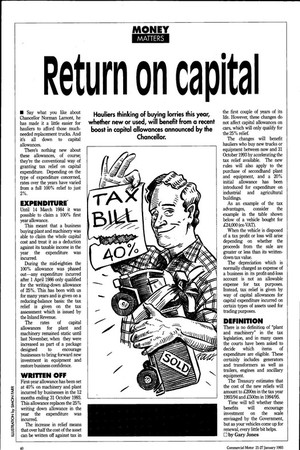Return on capital
Page 42

If you've noticed an error in this article please click here to report it so we can fix it.
Hauliers thinking of buying lorries this year, whether new or used, will benefit from a recent boost in capital allowances announced by the Chancellor.
• Say what you like about Chancellor Norman Lamont, he has made it a little easier for hauliers to afford those muchneeded replacement trucks. And it's all down to capital allowances.
There's nothing new about these allowances, of course; they're the conventional way of granting tax relief on capital expenditure. Depending on the type of expenditure concerned, rates over the years have varied from a full 100% relief to just 2 %.
EXPENDITURE.
Until 14 March 1984 it was possible to claim a 100% first year allowance.
This meant that a business buying plant and machinery was able to claim the whole capital cost and treat it as a deduction against its taxable income in the year the expenditure was incurred.
During the mid-eighties the 100% allowance was phased out—any expenditure incurred after 1 April 1986 only qualified for the writing-down allowance of 25%. This has been with us for many years and is given on a reducing-balance basis: the tax relief is given on the tax assessment which is issued by the Inland Revenue.
The rates of capital allowances for plant and machinery remained static until last November, when they were increased as part of a package designed to encourage businesses to bring forward new investment in equipment and restore business confidence.
WRITTEN OFF First-year allowance has been set at 40% on machinery and plant incurred by businesses in the 12 months ending 31 October 1993. This allowance replaces the 25% writing down allowance in the year the expenditure was incurred.
The increase in relief means that over half the cost of the asset can be written off against tax in the first couple of years of its life. However, these changes do not affect capital allowances on cars, which will only qualify for the 25% relief.
The changes will benefit hauliers who buy new trucks or equipment between now and 31 October 1993 by accelerating the tax relief available. The new rules will also apply to the purchase of secondhand plant and equipment, and a 20% initial allowance has been introduced for expenditure on industrial and agricultural buildings.
As an example of the tax advantages, consider the example in the table shown below of a vehicle bought for £24,000 (ex-VAT).
When the vehicle is disposed of a tax profit or loss will arise depending on whether the proceeds from the sale are greater or less than its writtendown tax value.
The depreciation which is normally charged as expense of a business in its profit-and-loss account is not an allowable expense for tax purposes. Instead, tax relief is given by way of capital allowances for capital expenditure incurred on certain types of assets used for trading purposes.
DEFINITION There is no definition of "plant and machinery" in the tax legislation, and in many cases the courts have been asked to decide which items of expenditure are eligible. These certainly includes generators and transformers as well as trailers, engines and ancillary equipment.
The Treasury estimates that the cost of the new reliefs will amount to £200m in the tax year 1993/94 and £500m in 1994/95.
Time will tell whether these benefits will encourage investment on the scale envisaged by the Government, but as your vehicles come up for renewal, every little bit helps.
1=1 by Gary Jones












































































